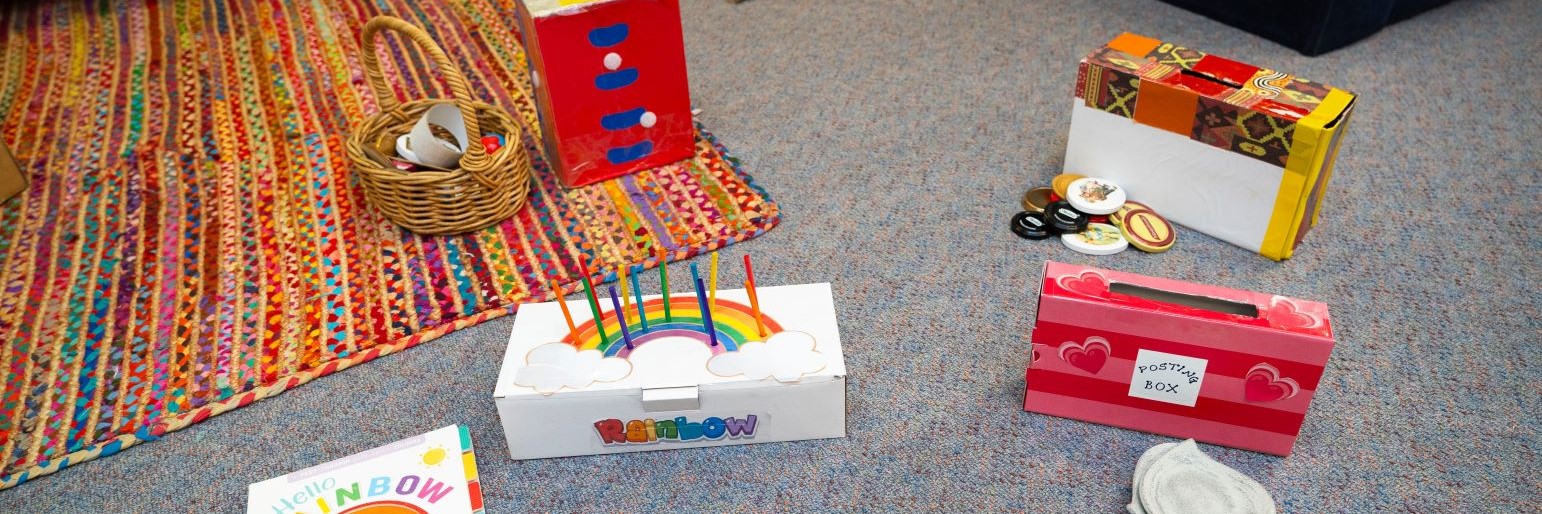Cardboard box play
Playing together
You don’t need to buy expensive toys — learning through play can occur with everyday items such as a cardboard box and a few craft materials.

Activity
Adults and children work together to create cars, cubbies or babies’ beds.
Encourage families to use their imagination. Provide art and craft materials, such as paint, markers, scissors, paper plates and sticky tape, to add to the construction.
What you'll need
- Paint
- Markers
- Rug
- Scissors
- Craft and collage materials
- Knife
- Cushions
- A big cardboard box
- Small cardboard boxes
Words to use
- Box, cardboard
- Big, huge, large, enormous
- Side, corner, top, bottom
- Inside, outside, edge
- Car, train, house, boat
- Think, wonder, idea, plan
Questions to discuss
- Can you fit in that box?
- What could you use for wheels?
- Does your house need a roof?
Learning through play
Ways to develop numeracy through play
- Talk about positions such as in, out, behind or in front.
- Do you have different size boxes?
- Are you too big to fit in the box?
- Is the box too small to fit teddy?
- If you make a cubby, how many windows does your house need? Where should we put the door? How tall does it need to be?
- Make cardboard sorting monsters with large holes for a mouth. Make each one a different colour to eat different coloured blocks.
- A large shallow box can be a road with a car park. Draw a road inside the box and draw some car parking spaces. Number the parks and cars too if you wish. Match cars with car parks.
- Measure your cars so the car parks are the right size.
Ways to develop literacy through play
- Turn a large box on its side with opening facing out. If you add a cushion or rug, you'll have a cosy nook just right for reading or dreaming.
- A very big box could be a cubby house. Use a pair of scissors or a sharp knife to cut out windows and doors. Talk with children about the size and placement of the windows and doorway.
- Use small boxes to make constructions, build garages or for dramatic play such as shopping.
- Talk to children about their plans and describe what they are doing, for example "Oh you are making a door for the cubby."
Extensions and variations to this activity
- Make cars, boats, trains, rockets or planes using boxes.
- Tape some streamers over the entrance to crawl through.
- To encourage active play, make an obstacle course with your cardboard box/es.
- You can also make a tunnel.
- Be a Jack-in-the-box. Sing: Jack was quiet down in his box until someone opened the lid…Boing. Action: Child hides in the box and jumps up.
- Add shredded paper or pieces of material inside the boxes for more sensory fun.
- Make a bean bag or ball-toss using a large box with a hole in it.
- Does your cubby have a kitchen? What sorts of yummy healthy foods could you make in there? Can you enjoy your healthy snacks in the cubby?
Supporting parent engagement in play
Play prompts:
- Encourage your child to use their imagination to create something with the boxes.
- Ask questions like “I wonder what this big box could be. What does it look like to you?”
- Use words like big, huge, large, enormous, plan, idea, think and wonder.
Parents or carers can:
- Comment on what their children are doing (say what you see).
- Talk in their home language.
- Use literacy and numeracy words (see words to use section above).
- Encourage their child to be purposeful and persistent.
- Encourage their child to be creative.
- Stay with their child and help them to use tricky tools such as the scissors or tape dispenser.
- Make up a story or engage in dramatic play using the box as a prop.
- Collect boxes and other recycled items to use for collage and box construction.
You can help families by:
- Modelling what you want them to do.
- Talking to them about the focus of the activity and what children might be learning.
- Writing up words that go with the activity.
- Making suggestions on what families can do at home.
Related Great Start activities
Great Start activities are for parents and carers to do with their children.


